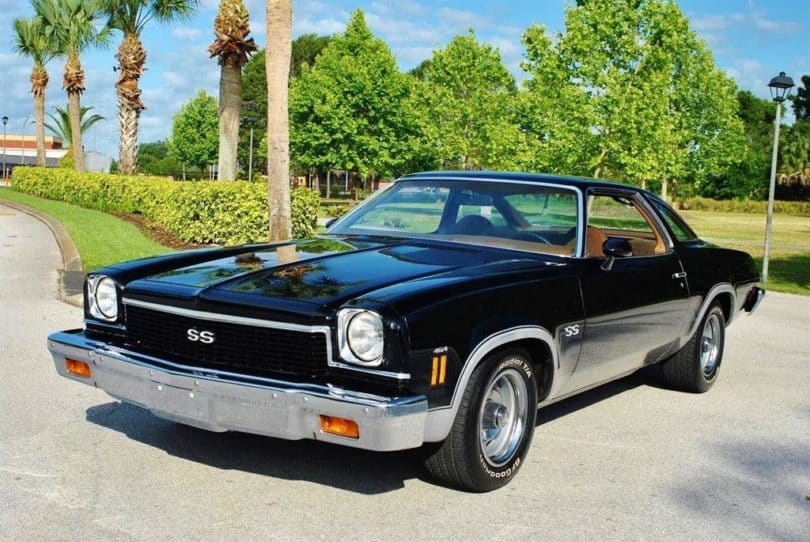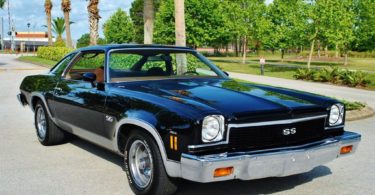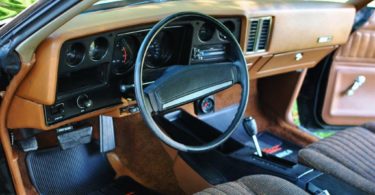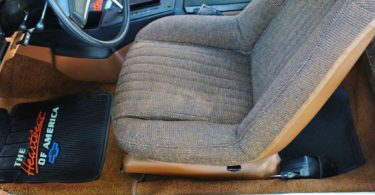
“Chevrolet is fielding an all-new intermediate Chevelle series at a time when competitive lines from Ford and Chrysler are one or more years old.” Motor Trend, 1973 Buyers Guide.
- 1973 marked the most extensive body style change by the Chevelle since the car’s inception in 1964.
- The long-lived sports coupe, with its pillarless hardtop, was replaced by the Colonnade Coupe.
- Formerly only standard on SS packages and the Heavy Chevy, every model came standard with front disc brakes.
Muscle Car Specifications
1973 marked the introduction of the third generation Chevelle, and after three years with little change to any model, the entire line underwent a thorough makeover. The year also marked the last year of the fabled SS line, as well as the notion of the Chevelle as the all-American muscle car (though Chevelles did go on to be strong NASCAR contenders throughout the mid-‘70s).
Introduced as the high-end luxury line of the Chevelle, the Laguna eclipsed the Malibu’s long held spot as the most luxurious models. The Malibu remained as a mid-level car, with the Deluxe replacing the simply named Chevelle as the base model.
The wheelbases were one of the only specifications to remain unchanged for 1973 at 112 inches for two door models and 116 for four door models. Body lengths, however, increased by five inches over the 1972 Chevelle, while widths increased by one. In addition to the new Colonnade model, all rooflines changed, and the front and rear ends looked markedly different. Total production for the year totaled 327,631.
Deluxe
The Deluxe replaced the Chevelle as the base model for the line. Though the body shapes and styles changed, this line was still a bare bones option to the more decked out (and expensive) Malibu and Laguna lines.
Standard engines remained similar to previous year models, with a 250 cubic inch six cylinder and a 307 cubic inch V-8, both of which were rated at 110 horsepower. The price of the least expensive model was lower than previous years, totaling $2,719.
Malibu
As the mid-level representative of the line, the Malibu still accounted for the majority of Chevelle sales in 1973, as it had for the entirety of Chevelle history to that point. One notable difference from previous years was that there was no convertible available in any form in 1973.
Like all models of the Chevelle, the Malibu came with an option to upgrade to the 350 cubic inch V-8, which produced 175 horsepower, or the 454 cubic inch V-8, rated at 245 horsepower. While the 454 was formerly only available for SS models, it was now an option for the Malibu, as well.
Chevelle Laguna
Easily distinguished from other Chevelles with its urethane front-end, the Laguna line was presented as the high-end luxury Chevelle beginning in 1973. The car came with the aforementioned 350 cubic inch engine as a base, and could upgrade to the 454
Super Sport
The SS option was available for its last year in 1973, being dropped at the end of the year model. Utilizing either the 350 or the 454 cubic inch motor, the SS option was available in a wide variety of Chevelle models, including some station wagons. While the power was relatively unchanged from the previous two years, economical concerns and the oncoming gas shortage marked a premature end of the SS, and of the Chevelle as a muscle car.
Muscle Car Competition
As in the two years leading up to 1973, muscle car innovation was pretty stagnant that year. The Pontiac and Oldsmobile representatives in the muscle car competitions (the GTO and 442, respectively) both received similar redesigns as the Chevelle as General Motors shifted to the Colonnade coupe. Both were already purely options on other models by 1973 and were on their way out.
Thought the Ford Torino had remained relatively unchanged since the 1972 model, it only had three years left before it was retired, as well. In addition to gas problems and environmental worries, skyrocketing insurance premiums and safety concerns were continually reducing the American public’s interest in muscle cars. It would be hard to define the end of the muscle car, but 1973 could easily be the year it died. It is certainly the year the Chevelle as a muscle car died alongside the SS name.
Engine Specifications
| Type | Size | Carb | Horse Power | Tourqe |
|---|---|---|---|---|
| I6 | 250ci | 1x1bbl | 100 hp @ 3800 rpm | 175 lb-ft @ 1600 rpm |
| V8 | 307ci | 1x2bbl | 115 hp @ 4000 rpm | 205 lb-ft @ 2000 rpm |
| V8 | 350ci | 1x4bbl | 175 hp @ 4000 rpm | 270 lb-ft @ 2400 rpm |
| V8 | 350ci | 1x2bbl | 145 hp @ 4000 rpm | 255 lb-ft @ 2400 rpm |
| V8 | 454ci | 1x4bbl | 275 hp @ 4000 rpm | 375 lb-ft @ 2800 rpm |
Performance Statistics
| 0 to 60 mph | Quarter Mile | Engine | Source |
|---|---|---|---|
| 9.5 sec | 16.7 sec | 454ci | Estimate |
It Was Time For A New Design
After five years, it was time for a new Chevelle. Large was out and small was beautiful. The car never looked that good when it was introduced but it has aged well. It definitely looks better that some of the designs that came later. I would rather have a 1970 or 1967 Chevelle but I could definitely live with one of these. It may even be cheaper to buy one of these than to purchase one of the more popular and expensive models. A sleeper indeed.













